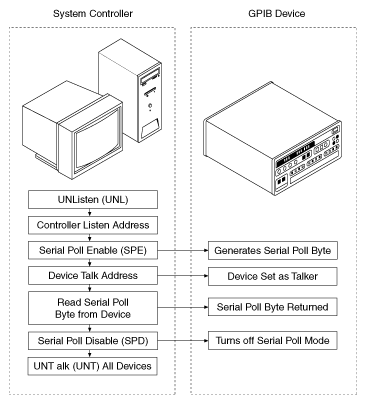Serial Polling
You can use serial polling to obtain specific information from GPIB devices when they request service. When the GPIB SRQ line is asserted, it signals the Controller that a service request is pending. The Controller must then determine which device asserted the SRQ line and respond accordingly.
IEEE 488 devices request service from the GPIB Controller by asserting the GPIB SRQ line. When the Controller acknowledges the SRQ, it serial polls each open device on the bus to determine which device requested service. Any device requesting service returns a status byte with bit 6 set and then unasserts the SRQ line. Devices not requesting service return a status byte with bit 6 cleared. Manufacturers of IEEE 488 devices use lower order bits to communicate the reason for the service request or to summarize the state of the device.
In addition to setting bit 6 when requesting service, IEEE 488.2 devices also use two other bits to specify their status. Bit 4, the Message Available bit (MAV), is set when the device is ready to send previously queried data. Bit 5, the Event Status bit (ESB), is set if one or more of the enabled IEEE 488.2 events occurs. These events include power-on, user request, command error, execution error, device-dependent error, query error, request control, and operation complete. The device can assert SRQ when ESB or MAV is set, or when a manufacturer-defined condition occurs.
Serial polling obtains specific information from a device. When you serial poll, the Controller sends a special command message—Serial Poll Enable (SPE)—to the device, directing it to return its serial poll status byte. The SPE message sets the IEEE 488.1 serial poll mode in the device, so when the device is addressed to talk, it returns a single 8-bit status byte. This serial poll status byte is different for each type of instrument; except for one bit, you must refer to the instrument user manual for information on the other bits. Bit 6 (hex 40) of any serial poll status byte indicates whether a device requested service by asserting the SRQ line. The device uses the other seven bits of the status byte to specify why it needs attention.
After the Controller reads the status byte, it sends another command message, Serial Poll Disable (SPD), to the device. The SPD message terminates the serial poll mode, thus returning the device to its normal Talker/Listener state. Once a device requesting service is serial polled, it usually unasserts the SRQ line.
When a serial poll is conducted, the following sequence of events occurs:
